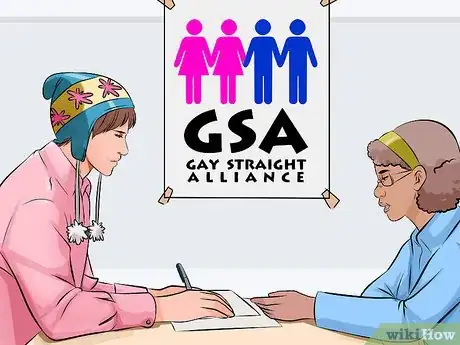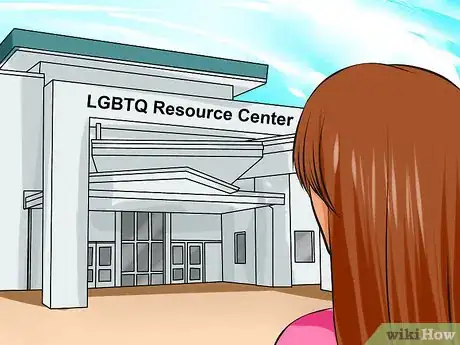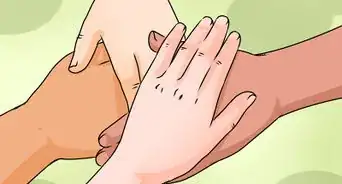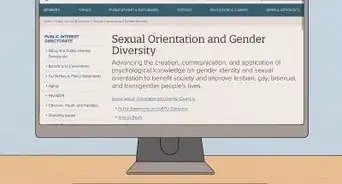This article was co-authored by Marissa Floro, PhD. Dr. Marissa Floro, Ph.D. is a Psychologist and Instructor at Stanford University’s Weiland Health Initiative and adjunct faculty at the University of San Francisco. Dr. Floro received her Ph.D. in Counseling Psychology from Loyola University Chicago, focusing on the intersections of race, attraction, and gender. Dr. Floro’s continued clinical, teaching, and advocacy work focuses on sexual and gender diversity, racial identity and belonging, and liberation from oppressive systems and structures.
wikiHow marks an article as reader-approved once it receives enough positive feedback. This article has 18 testimonials from our readers, earning it our reader-approved status.
This article has been viewed 2,088,704 times.
Sexual orientation is not binary—it exists along a spectrum. As a result, identifying your sexual preferences and accepting your sexual orientation is often a long, complex, and emotional journey. Embarking on this process may feel overwhelming. Empower yourself to uncover your true self. Remain honest and open with yourself—trust your instincts. Listen to your body. Acknowledge your true feelings and tendencies. Accept what you discover about yourself throughout the process.
Steps
Identifying Your Sexual Preferences
-
1Evaluate why you are questioning your sexual orientation. The decision to explore your sexual orientation should be a personal choice. Question your sexuality because it is a process you need to complete, not because members of society are telling you that you are a lesbian. Devote time to self-reflection. Keeping a journal, private blog, or personal video diary can provide outlets for self-exploration and discovery.
-
2Identify romantic attraction to women. Romantic attraction involves seeing a woman and wanting to date her. Consider the following:
- Do you check out women? Do you notice a woman’s smile, quirks, and features?
- Does your heart race and your stomach flutter when you see an attractive woman?
- Are you constantly daydreaming about a specific woman?
- Does the idea of holding hands, going out with, or kissing a woman make you excited?
-
3Think about whether you are sexually attracted to women. Do you think certain women look hot? Are you sexually aroused by women? Do you like to imagine what women would look like if they were naked? Do you prefer to kiss and have sex with women? If so, you are likely sexually attracted to women.
-
4Take a sexual orientation test. If you are struggling to identify your sexual preferences, taking a sexual orientation test may reveal new truths about your sexual preferences. If you are fairly confident in your ability to identify your sexual preferences, the test results may confirm your self-assessment. Keep in mind: online sexual orientation tests are often not official and rather unhelpful. Some may set you up in a hypothetical sexual situation with someone of your gender and ask if you 'like it', but that doesn't prove anything. You could be lesbian and still not enjoy the sexual activity they describe. The Kinsey Scale test is probably the most reliable because it was made by an actual psychologist.
- Take the Kinsey Scale test. The Kinsey Scale assesses sexual orientation. A test was created to measure where you fall on the scale—from straight to gay. You will not be labeled straight, bisexual, or gay. The test is composed of 13 true/false questions and asks very little demographic information.[1]
- Take the Epstein Sexual Orientation Inventory (ESOI) test. Created by Robert Epstein, one of America’s most distinguished psychologists, the ESOI test evaluates an individual’s sexual orientation. Instead of labeling your sexual orientation, the test results reveal you where you fall on a sexual orientation continuum. This 18 question test only requires 5 minutes of your time.[2]
Acknowledging and Accepting Your Self-discoveries
-
1Acknowledge that your sexual or romantic preferences exist. It is natural to avoid or overcompensate for your sexual desires—it is normal to feel scared and overwhelmed! In order to move forward, you must be vulnerable and honest with yourself. Once you stop suppressing your sexual or romantic preferences and start acknowledging that they exist, you can work towards self-acceptance.
- Sexual and romantic preference exists along a continuum. It is fluid, not static. Your sexual preference may not align with the standard definitions and that is more than O.K. It is extremely common and normal.
- Bisexual people may not be equally attracted to members of all genders. Many prefer a certain gender over others.
- Whether you have to be exclusively attracted to non-men to identify as a lesbian is still a controversial subject.
- Sapphic is a term used to describe non-men who are attracted to non-men, whether exclusively or not.
- Sexual and romantic preference exists along a continuum. It is fluid, not static. Your sexual preference may not align with the standard definitions and that is more than O.K. It is extremely common and normal.
-
2Love yourself. On the journey towards self-acceptance, acknowledging that you are a lesbian is the first step in a gradual process. Acceptance often does not occur overnight. As you become more comfortable with your sexual orientation, you will recognize that it does not define you as an individual. Strive to live your life unapologetically—rid yourself of guilt and shame.
-
3Practice positive self-talk. If you were raised in a highly conservative household or brought up in an intolerant community, your sexual identity may conflict with the morals or religious beliefs instilled in you as a child. Intentionally altering your language and thoughts are highly effective methods of shifting your perception of right and wrong. Stop telling yourself that you are unworthy of love and happiness and start believing in your value as a human being. Instead of telling yourself that being lesbian is a sin, acknowledge that your sexual preference is natural, healthy, and acceptable.
- Start identifying any negative self-talk tendencies. What harmful lies are you telling yourself? Do these thoughts arise due to specific situations, like a conversation with a family member?
- Replace these negative phrases with personally crafted, positive mantras. When you catch yourself saying, "I am not worthy" or "I don't deserve happiness," take a deep breath, put a smile on your face and tell yourself that you are "valuable, loved, and entitled to lead an authentic life that makes you happy!"
-
4Determine if it is safe to come out. Deciding when to come out is often an emotionally agonizing decision with potential consequences. Before coming out to your family, friends, and classmates, determine if it is safe to do so.[3] [4]
- Remember—you are not obligated to come out to anyone! Your identity and preferences are valid no matter who knows about them.[5]
- Meet with a pediatrician or counselor to theorize about how your parents and peers may react. Consider how your parents and peers discuss and treat queer people. Think about how they react to difficult news.[6]
- If your parents or peers are openly hostile towards queer people, be cautious and selective.[7]
-
5Recognize that your journey of self-acceptance might impact your relationships with others. While discovering and accepting your sexual orientation is an extremely personal journey, it is necessary to accept that it might impact your relationship with others. Coming out to friends, family members, and colleagues can be stress-inducing! It is not necessary to come out to everyone you know or meet. When you feel comfortable and confident, breach the subject with those you feel comfortable with first. Be prepared for negative responses and value positive reactions.
-
6Meet with a counselor. Processing your sexual identity and accepting yourself is a long, complex process. Coping with the social stigma is mentally and emotionally draining. Meeting with a qualified therapist—a professional experienced in counseling members of the LGBTQ community—can help you navigate this process. A therapist can help you accept your sexual orientation and assist you through the process of coming out to your family and peers.
Living Authentically
-
1Define yourself and live your life. Although society portrays a stereotypical lesbian, the lesbian community is made up of diverse women from a multitude of backgrounds. As you explore and experience the lesbian community, make an effort to learn anything and everything there is to know about your new community. Over time, you will discover where you fit in the community. You will personally define what it means to be a lesbian and live your life accordingly.
-
2Educate yourself about the LGBTQ community. Establishing a foundation of knowledge about the LGBTQ community—its past, present, and future—will enlighten you. It will make you aware of potential obstacles and provide you with insight into how to overcome the barriers.
- Learn how to distinguish between sex, gender; sexual orientation, and familiarize yourself with the spectrum of sexual orientation.
- Read academic literature—scholarship on LGBTQ topics is burgeoning!
- Stay up-to-date on LGBTQ issues covered in news.
-
3Surround yourself with supportive people. There is no worse pain than that of isolation. Throughout your journey of self-acceptance, it is essential to have a reliable friend or a receptive support group. These people will provide you with advice and comfort when the journey gets difficult.[8]
- Confide in friends and family members you can trust.
- Join a local support group or become a member of an online support community.[9]
- Attending a LGBTQIA-affirming church, temple, or house of worship will place you in contact with supportive men and women that share your religious values.
- gaychurch.org provides a list of LGBTQI-affirming Christian churches.
- A quick internet search will provide you with a list of LGBTQI-affirming churches, temples, or houses of worship in your area.
-
4Establish a Gay-Straight Alliance. Gay-Straight Alliances (GSA) provide high schoolers and middle schoolers with a safe place to discuss and discover their sexual orientation and identity. GSAs provide teens with a support group and a social network. If your school does not have a GSA, work with school administrators to establish a club.
-
5Locate and use a LGBTQ Resource Center. LGBTQ Resource Centers are found in cities and on college campuses. Resource centers connect students with helpful tools and trustworthy services. They provide LGBTQ students with a safe, inclusive place to explore their sexual orientation and identity.
References
- ↑ http://vistriai.com/kinseyscaletest/
- ↑ http://mysexualorientation.com/
- ↑ http://www.ncbi.nlm.nih.gov/pmc/articles/PMC2603519/
- ↑ Marissa Floro, PhD. Counseling Psychologist. Expert Interview. 18 February 2021.
- ↑ Marissa Floro, PhD. Counseling Psychologist. Expert Interview. 18 February 2021.
- ↑ http://www.ncbi.nlm.nih.gov/pmc/articles/PMC2603519/
- ↑ http://www.ncbi.nlm.nih.gov/pmc/articles/PMC2603519/
- ↑ Marissa Floro, PhD. Counseling Psychologist. Expert Interview. 18 February 2021.
- ↑ https://www.psychologytoday.com/blog/finding-love/201305/why-coming-out-isnt-just-gay-people
About This Article
Figuring out if you're a lesbian can be a long and difficult journey, but a good place to start is by considering whether you experience romantic attraction or sexual arousal toward women. For example, if you check women out, daydream about a particular woman, or feel your heart race whenever you see an attractive woman, then you may be a lesbian. You could also take a sexual orientation test, like the Kinsey Scale test, which uses 13 true or false questions to place you on a scale from straight to gay. However, take these results with a grain of salt, since your sexual preferences could change over time and that's perfectly okay. As long as you love and accept yourself, you can live an authentic life full of self-discoveries. For more advice from our co-author, including how to determine if you are safe to come out as a lesbian, read on.














































































